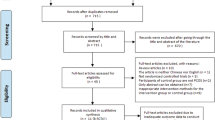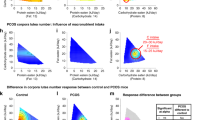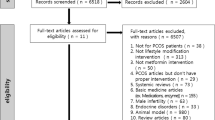Abstract
Background/Objective:
Diet and lifestyle modifications may be of benefit in the management of polycystic ovary syndrome (PCOS), but there is a paucity of data on these behaviours in women with PCOS. This study aims to address this through a comprehensive investigation of the habitual diet and activity patterns of UK women with PCOS and their alignment with dietary recommendations for health.
Subjects/Methods:
A 7-day-estimated food and activity diary and questionnaire was completed by 210 women with PCOS for calculation of activity levels, energy and nutrient intakes and dietary glycaemic index (GI).
Results:
Mean (s.d.) body mass index (BMI) was 27.4 (7.3) kg/m2 (n=183), with 53% of women with PCOS having a BMI>25 kg/m2. Of the overweight women, approximately half were not achieving sufficient physical activity to promote weight loss. More frequent eating episodes and a lower BMI were weakly associated (r=−0.158, P=0.034). Mean percentage energy from fat was 38 (7)% (12% energy from saturated fat), with 68% of women with PCOS consuming > 35% energy from fat. Mean dietary GI was higher in obese women with PCOS, compared with healthy weight women with PCOS (55.7 (3.4) and 53.8 (4.0), respectively; P=0.043).
Conclusion:
Many women with PCOS are not achieving dietary intakes and levels of physical activity that optimise symptom management and disease prevention. Advice should focus on fat quality and quantity and carbohydrate modification. There is a need for further robust research into the role of dietary GI in the PCOS population.
This is a preview of subscription content, access via your institution
Access options
Subscribe to this journal
Receive 12 print issues and online access
$259.00 per year
only $21.58 per issue
Buy this article
- Purchase on Springer Link
- Instant access to full article PDF
Prices may be subject to local taxes which are calculated during checkout
Similar content being viewed by others
References
Ainsworth BE, Haskell WL, Whitt MC, Irwin ML, Swartz AM, Strath SJ et al. (2000). Compendium of physical activities: an update of activity codes and MET intensities. Med Sci Sports Exerc 32, 498–516.
Aston L (2006). Glycaemic index and metabolic disease. Proc Nutr Soc 65, 125–134.
Aston L, Gambell JM, Lee DM, Bryant SP, Jebb SA (2008). Determination of the glycaemic index of various staple carbohydrate-rich foods in the UK diet. Eur J Clin Nutr 62, 279–285.
Atkinson F, Foster-Powell K, Brand-Miller JC (2008). International tables of glycemic index and glycemic load values: 2008. Diabetes Care 31, 2281–2283.
Avery J, Braunack-Mayer A (2007). The information needs of women diagnosed with Polycystic Ovarian Syndrome - implications for treatment and health outcomes. BMC Women′s Health 7, 9.
Azziz R, Carmina E, Dewailly D, Diamanti-Kandarakis E, Escobar-Morreale HF, Futterweit W et al. (2006). Position statement: criteria for defining polycystic ovary syndrome as a predominantly hyperandrogenic syndrome: an Androgen Excess Society guideline. J Clin Endocrinol Metab 91, 4237–4245.
Balen A (2004). The pathophysiology of poylcytic ovary syndrome: trying to understand PCOS and its endocrinology. Best Pract Res Clin Obstet Gynaecol 18, 685–706.
Balen A, Dresner M, Scott E, Drife J (2006). Should obese women with polycystic ovary syndrome receive treatment for infertility? BMJ 332, 434–435.
Barclay A, Flood VM, Rochtchina E, Mitchell P, Brand-Miller JC (2007). Glycemic index, dietary fiber, and risk of type 2 diabetes in a cohort of older Australians. Diabetes Care 30, 2811–2813.
Barclay A, Petocz P, McMillan-Price J, Flood V, Prvan T, Mitchell P et al. (2008). Glycemic index, glycemic load, and chronic disease risk—a meta-analysis of observational studies. Am J Clin Nutr 87, 627–637.
Bates B, Lennox A, Swan G (2010). National Diet and Nutrition Survey: headline results from Year 1 of the Rolling Programme (2008/2009). Available at: http://www.food.gov.uk/science/dietarysurveys/ndnsdocuments/ndns0809year1, accessed 28th September 2010.
Brand-Miller JC, Allwan C, Mehalski K, Brooks D (1998). The glycaemic index of further Australian foods. Proc Nutr Soc 22, 110.
Carmina E (2006). Metabolic syndrome in polycystic ovary syndrome. Minerva Ginecol 58, 109–114.
Carmina E, Legro R, Stamets K, Lowell J, Lobo R (2003). Difference in body weight between American and Italian women with polycystic ovary syndrome: influence of the diet. Hum Reprod 18, 2289–2293.
Department of Health (1991). Dietary Reference Values for Food Energy and Nutrients for the United Kingdom. Report on Health and Social Subjects 41. The Stationary Office. HSMO: London.
Department of Health (2004). At Least Five a Week: Evidence on the Impact of Physical Activity and its Relationship to Health. A Report from the Chief Medical Officer. Department of Health Publications: London.
Diamanti-Kandarakis E (2008). Polycystic ovarian syndrome: pathophysiology, molecular aspects and clinical implications. Expert Rev Mol Med 10, e3.
Dokras A (2008). Cardiovascular disease risk factors in polycystic ovary syndrome. Semin Reprod Endocrinol 26, 39–44.
Douglas C, Norris L, Oster R, Darnell B, Azziz R, Gower B (2006). Difference in dietary intake between women with polycystic ovary syndrome and healthy controls. Fertil Steril 86, 411–417.
Drummond S, Crombie NE, Cursiter MC, Kirk TR (1998). Evidence that eating frequency is inversely related to body weight status in male, but not female, non-obese adults reporting valid dietary intakes. Int J Obes Relat Metab Disord 22, 105–112.
Ehrmann DA, Barnes RB, Rosenfield RL, Cavaghan MK, Imperial J (1999). Prevalence of impaired glucose tolerance and diabetes in women with polycystic ovary syndrome. Diabetes Care 22, 141–146.
Farshchi H, Taylor MA, Macdonald IA (2005). Beneficial metabolic effects of regular meal frequency on dietary thermogenesis, insulin sensitivity, and fasting lipid profiles in healthy obese women. Am J Clin Nutr 81, 16–24.
Foster-Powell K., Holt S, Brand-Miller J (2002). International table of glycemic index and glycemic load values. Am J Clin Nutr 76, 55–56.
Franks S (1995). Polycystic ovary syndrome. N Engl J Med 333, 853–861.
Frost G, Dornhurst A (2000). The relevance of the glycaemic index to our understanding of dietary carbohydrates. Diabet Med 17, 336–345.
Galgani J, Uuauy R, Aguirre CA, Díaz EO (2008). Effect of the dietary fat quality on insulin sensitivity. Br J Nutr 100, 471–479.
Gibson RS (2006). Measuring food consumption of individuals. In: Gibson RS (ed.). Principles of Nutritional Assessment, 2nd edn. Oxford University Press: New York.
Goldberg G, Black AE, Jebb SA, Cole TJ, Murgatroyd PR, Coward WA et al. (1991). Critical evaluation of energy intake using fundamental principles of energy physiology: Derivation of cut-off limits to identify under-recording. Eur J Clin Nutr 45, 569–581.
Hampl JS, Heaton CL, Taylor CA (2003). Snacking patterns influence energy and nutrient intakes but not body mass index. J Hum Nutr Diet 16, 3–11.
Herriot A, Whitcroft S, Jeanes Y (2008). An retrospective audit of patients with polycystic ovary syndrome: the effects of a reduced glycaemic load diet. J Hum Nutr Diet 21, 337–345.
Hirschberg A, Naessén S, Stridsberg M, Byström B, Holtet J (2004). Impaired cholecystokinin secretion and disturbed appetite regulation in women with PCOS. Gynecol Endocrinol 19, 79–87.
Humphreys L, Costarelli V (2008). Implementation of dietary and general lifestyle advice among women with polycystic ovarian syndrome. J R Soc Promot Health 128, 190–195.
Jeanes Y, Barr S, Smith K, Hart KH (2009). Dietary management of women with polycystic ovary syndrome in the United Kingdom: the role of dietitians. J Hum Nutr Diet 22, 551–558.
Kiddy D, Hamilton-Fairley D, Bush A, Short F, Anyaoku V, Reed MJ et al. (1992). Improvement in endocrine and ovarian function during dietary treatment of obese women with polycystic ovary syndrome. Clin Endocrinol 36, 105–111.
Lindholm A, Andersson L, Eliasson M, Bixo M, Sundstrom-Poromaa I (2008). Prevalence of symptoms associated with polycystic ovary syndrome. Int J Gynaecol Obstet 102, 39–43.
McMillian-Price J, Petocz P, Atkinson F, O’Neill K, Samman S, Steinbeck K et al. (2006). Comparison of 4 diets of varying glycemic load on weight loss and cardiovascular risk reduction in overweight and obese young adults. Arch Intern Med 166, 1466–1475.
Moran LJ, Noakes M, Clifton PM, Tomlinson L, Norman RJ (2003). Dietary composition in restoring reproductive and metabolic physiology in overweight women with polycystic ovary syndrome. J Clin Endocrinol Metab 88, 812–818.
Office for National Statistics (2010). United Kingdom population by ethnic group. United Kingdom Census. Available at: www.statistics.gov.uk, accessed 8 April 2010.
Qublan H, Yannakoula E, Al-Qudah MA, El-Uri FI (2007). Dietary intervention versus metformin to improve the reproductive outcome in women with polycystic ovary syndrome. A prospective comparative study. Saudi Med J 28, 1694–1699.
Riccardi G, Giacco R, Rivellese AA (2004). Dietary fat, insulin sensitivity and the metabolic syndrome. Clin Nutr 23, 447–456.
Risérus U (2008). Fatty acids and insulin sensitivity. Curr Opin Clin Nutr Metab Care 11, 100–105.
Ross R, Janssen I, Dawson J, Kungl AM, Kuk JL, Wong SL et al. (2004). Exercise-induced reduction in obesity and insulin resistance in women: a randomized controlled trial. Obes Res 12, 789–798.
Sharma A, Walker DM, Atiomo W (2010). National survey on management of weight reduction in PCOS women in the United Kingdom. Eur J Obstet Gynecol Reprod Biol 152, 181–185.
Stamets K., Taylor D, Kunselman A, Demers L, Pelkman C, Legro R (2004). A randomized trial of the effects of two types of short-term hypocaloric diets on weight loss in women with polycystic ovary syndrome. Fertil Steril 81, 630–637.
Thomas DE, Elliott EJ, Baur L (2007). Low glycaemic index or low glycaemic load diets for overweight and obesity. Cochrane Database Syst Rev 18, CD005105.
Truby H, Baic S, deLooy A, Fox KR, Livingstone MB, Logan CM et al. (2006). Randomised controlled trial of four commercial weight loss programmes in the UK: initial findings from the BBC ‘diet trials’. BMJ 332, 1309–1314.
van Bakel M, Kaaks R, Feskens EJ, Rohrmann S, Welch AA, Pala V et al. (2009). Dietary glycaemic index and glycaemic load in the European Prospective Investigation into Cancer and Nutrition. Eur J Clin Nutr 63, S188–S205.
Vigorito C, Giallauria F, Palmonba S, Cascella T, Manguso F, Lucci R et al. (2007). Beneficial effects of a three-month structured exercise training program on cardiopulmonary functional capacity in young women with polycystic ovary syndrome. J Clin Endocrinol Metab 92, 1379–1384.
Wijeyaratne CN, Balen AH, Barth JH, Belchetz PE (2002). Clinical manifestations and insulin resistance (IR) in polycystic ovary syndrome (PCOS) among South Asians and Caucasians: is there a difference? Clin Endocrinol 57, 343–350.
Wright CE, Zborowski JV, Talbott EO, McHugh-Pemu K, Youk A (2004). Dietary intake, physical activity, and obesity in women with polycystic ovary syndrome. Int J Obes Relat Metab Disord 28, 1026–1032.
Acknowledgements
Funding from Roehampton University.
Author information
Authors and Affiliations
Corresponding author
Ethics declarations
Competing interests
The authors declare no conflict of interest.
Additional information
Supplementary Information accompanies the paper on European Journal of Clinical Nutrition website
Supplementary information
Rights and permissions
About this article
Cite this article
Barr, S., Hart, K., Reeves, S. et al. Habitual dietary intake, eating pattern and physical activity of women with polycystic ovary syndrome. Eur J Clin Nutr 65, 1126–1132 (2011). https://doi.org/10.1038/ejcn.2011.81
Received:
Revised:
Accepted:
Published:
Issue Date:
DOI: https://doi.org/10.1038/ejcn.2011.81
Keywords
This article is cited by
-
Comparison of physical activity levels and dietary habits between women with polycystic ovarian syndrome and healthy controls of reproductive age: a case-control study
BMC Women's Health (2024)
-
Association of dietary inflammatory index with C-reactive protein and interleukin-6 in women with and without polycystic ovarian syndrome
Scientific Reports (2024)
-
Pathophysiology and Nutritional Approaches in Polycystic Ovary Syndrome (PCOS): A Comprehensive Review
Current Nutrition Reports (2023)
-
Associations of diet, physical activity and polycystic ovary syndrome in the Coronary Artery Risk Development in Young Adults Women’s Study
BMC Public Health (2021)
-
Exercise, or exercise and diet for the management of polycystic ovary syndrome: a systematic review and meta-analysis
Systematic Reviews (2019)



